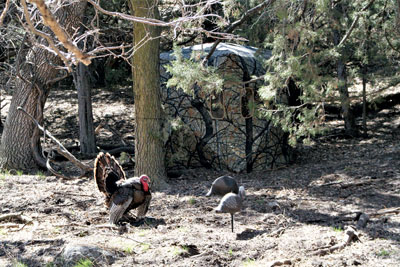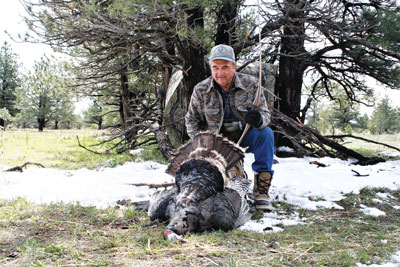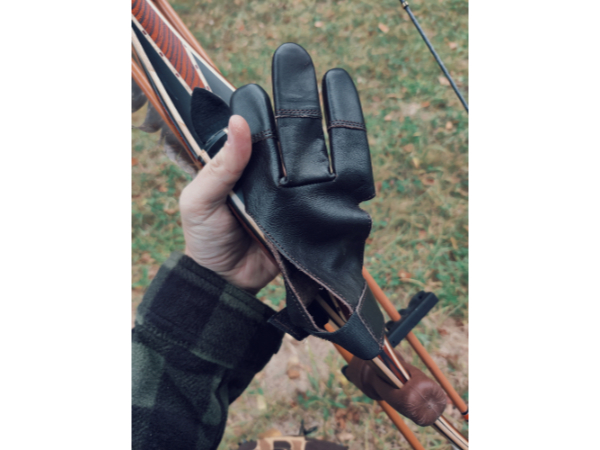As hunting wild turkeys becomes more popular, I talk to quite a few folks who really like to pursue the big birds with bow and arrow. After hunting turkeys for thirty or so years, I think they are the finest game birds that a bowhunter can hunt. They can be extremely tough once they get a little education about being hunted. And I mean a little education. Once you trick a big gobbler into coming to your decoys and shoot at him or spook him before getting a shot, he usually becomes very wary. I have done that many times and only in a few instances have I been able to call the same bird in close again. The bowhunters I talk with agree.
One time over in Nebraska where I hunt early, as their season opens a couple of weeks ahead of our Colorado season, I called in a couple of big birds to my enticing decoys. At six yards, I waited until the biggest strutting gobbler turned away from me. Then I loosed an arrow at the center of his fan. The next thing I saw was my arrow ricocheting off his back, feathers flying, and the gobbler rolling, tumbling, and then getting his feet under him and heading for the timber at warp speed. As I went over the shot in my mind I realized the hit had been a little high, and the arrow had zipped up his back and into orbit! I couldn’t believe I had blown such an easy shot. I didn’t see another bird close the rest of the day.

The author’s standard set up, with decoys within six yards of the blind for close shots.
The following morning, I was in the blind before daylight. I heard some turkeys gobbling up in the timber and then a few minutes later they flew down a couple of hundred yards to the east of me. I yelped a couple of times, gobbled once, and shut up. I always start out calling very conservatively and then wait to see what happens. I immediately heard a thundering gobble to the west of my position, and it was close. I turned around, grabbed my longbow, and got ready. When three big gobblers came strutting in right into my decoys, I noticed one was limping. He was a big bird, and I planted a wood arrow tipped with a sharp Switchblade head right under his red neck! He just sat back on his tail deader than a doornail.
The other two wandered off, and I got out of the blind excited to have taken a good Rio Grande gobbler. When I examined him, I saw a streak up his back where my arrow had blown feathers off during the previous day’s shot. I was really surprised that he decoyed back in, but I think a lot of that had to do with coming in with the two other gobblers. That’s the only gobbler that has given me a second shot on the same hunt. They usually just don’t come in and get fooled a second time.
I’ve taken nineteen gobblers, both Rio Grande and Merriam’s, with my longbows and recurves. I would just as soon hunt turkeys as just about any other game except sheep and big mulie bucks. Taking those birds over the years, I have shot them at just about every imaginable angle with hits in many parts of the bird. I’ve contemplated and imagined any number of “best places to shoot.” One thing for sure is that I like close shots. I never put my decoys farther out than six or seven yards from my blind. It seems to me that once a gobbler commits to your decoys after getting within twenty-five yards, he is committed no matter how far the decoys are from the blind.
I once hunted near the base of a timbered bluff within twenty yards of an ancient sheep fence. The fence was made from 4-inch square woven wire, but had many larger holes rusted through it and in some places was only a foot high. I had to make a level spot for my blind, and then I put the decoys two yards in front of it: a hen in a submissive position and a fanned out gobbler decoy right behind her. It was ten a.m. when I got into the blind all set up for the hunt.
I called sparingly off and on until noon and finally heard an answering gobble from a long way off over the bluff. I immediately gobbled, and the bird answered. We kept this up, and I could tell he was getting closer, coming down through the timber in front of me on the other side of the old fence. Two minutes later, he broke out of the trees running. I was shocked to see a second big gobbler running by his side.
When they reached the fence, they would not jump or fly over it even though it was low right there. They could see the decoys and were going crazy trying to find a way through the fence. They finally ran down the fence to the left and came through a long-defunct gate, turned, and sprinted to the decoys. The closest gobbler ran up to the hen decoy, and spread his wings over her. I had to raise up slightly to take the steep downhill shot at three yards, and then I ruined his whole day! The other bird jumped down the hill, looked back at the decoys and walked off. I think the noise of the arrow going through the mesh window and thumping my prize scared him just enough to make him jump down the hill. He sure wasn’t spooked, though. I hit the other turkey down through the back, and he only went a couple of feet off the decoy. I know the arrow was so close it never had time to straighten out.
Early on I was using one of my Double Bull blinds before screened-in windows. The windows had easy opening flaps so I could keep it dark behind me as I was looking out the front where I expected the birds to come in from. I had several gobblers come to within thirty yards, turn, and leave. I also had a couple of whitetails come down out of the timber, immediately slam on the brakes, stare at the blind for a few seconds, and spook. I got out of the blind, walked over to where the does were standing, and looked back to see what had spooked them. I was shocked to find myself looking at two big black eyes—the windows on my blind. That didn’t spook all the birds, but it bothered them enough that I screened in all the windows and practiced shooting through the screens. It took a little getting used to, but now I don’t even pay attention to the screen. It doesn’t affect arrow flight as long as the screens are tight. I just pin the screens on with safety pins in four corners.

Marv with a Rio Grande turkey taken in Nebraska.
I’ve lost a few birds, but most of those were just shot through the feathers. When gobblers are strutting, they are puffed up much bigger than their body under the feathers. It is really difficult to pick a spot to guarantee a quick kill. Hitting right at the top of the thighs from broadside breaks them down and makes a quick kill, but it takes a precise shot to do it. I prefer a dead-on front or rear end shot, as that gives you a better perspective of a perfect spot to concentrate upon. Any aiming spot on a turkey is quite small, as there are a lot of feathers to look at and a small kill area. Quartering away shots are good, as are those quartering toward you. But one must think about where the arrow will exit as well as where it will enter. This thought process helps pick the spot to shoot at. That takes some discipline, but if you do that on all game you shoot at it will become natural and easier to do.
Coyotes can pose another problem. I shot a big bird at the base of some trees in a meadow. He flew straight up for fifty feet, leveled out, and dropped in some high weeds. I got out of the blind, took my bow and hip quiver, and went over to where I thought he had landed. It took me fifteen minutes to find the spot, but luckily I found a pretty good blood trail. Turkeys are notorious for not leaving blood trails as the feathers soak up the blood before it has a chance to hit the ground. But this one left a good trail, and I followed it sixty yards up into the timber to a spot where he laid down. But, no gobbler. I looked carefully and could see tracks and drag marks where a coyote had grabbed my bird and headed up into the timber. I couldn’t believe he found that bird so quickly and made off with it. I was bummed, but had to laugh about it, too. That old coyote was just doing his duty to get fed.
A couple of years later in the same spot, I shot another gobbler that ran up under a big pine tree 100 yards up the hill. I looked with my binoculars as he went under the low-hanging branches and felt confident he would go no further. I still had several dozen birds in the open fifty yards in front of me. Since I had a second tag I was excited to try for a “double,” as I had never done that. I worked those birds for most of an hour without bringing them in to the decoys. They just fed off with no interest in my calling. I waited until they were out of sight and then went up to the big tree to get my bird. Again I got a shock as there were only feathers and some bones left. A coyote had eaten almost the whole bird. He had no idea I was there in the blind, and I couldn’t see under the tree because of the low hanging limbs. Again, I had to laugh about a wary old coyote getting the best of me. When I told Judy about the coyote, she said, “That’s what you get for being greedy and wanting two birds instead of going right after the first one.”
If you’ve never hunted turkeys, give it a try. The population has exploded all around the country, and most seasons are long. Some states have two and three bird limits, too. It is really fun to call and decoy these big birds into close range. I use my regular hunting broadheads on turkeys rather than any of the huge, fancy heads some are using to head-shoot the birds. You can try all the gadgets to help you be more successful, but we choose traditional equipment for the challenge of the hunt, not a need to kill. Just pick your spots carefully and hit your turkeys in the right place.
Equipment Note: Marv Clyncke carries one of his regular big game bows on his turkey hunts—usually a Black Canyon longbow or his 1959 Bear Kodiak.







Leave A Comment